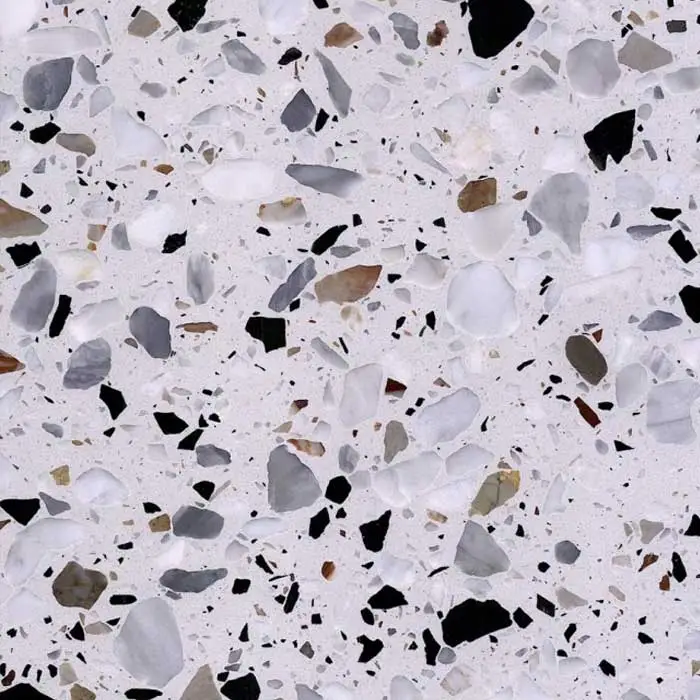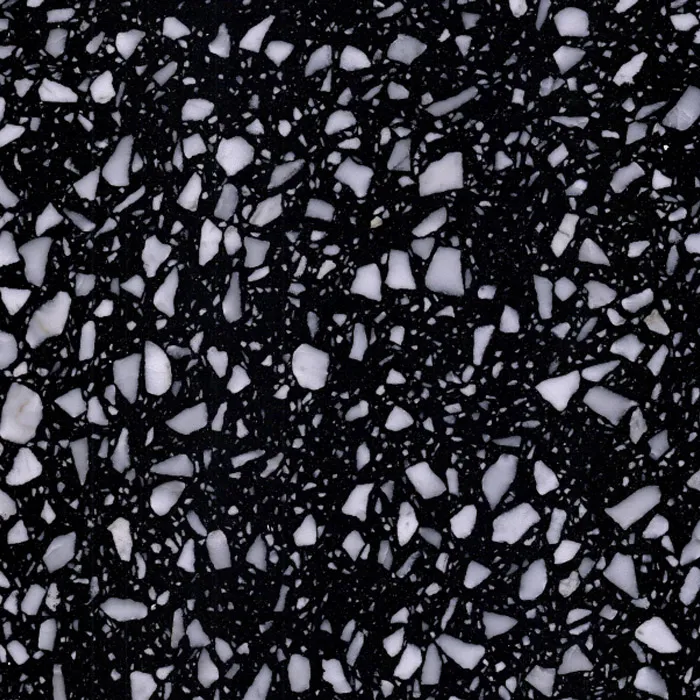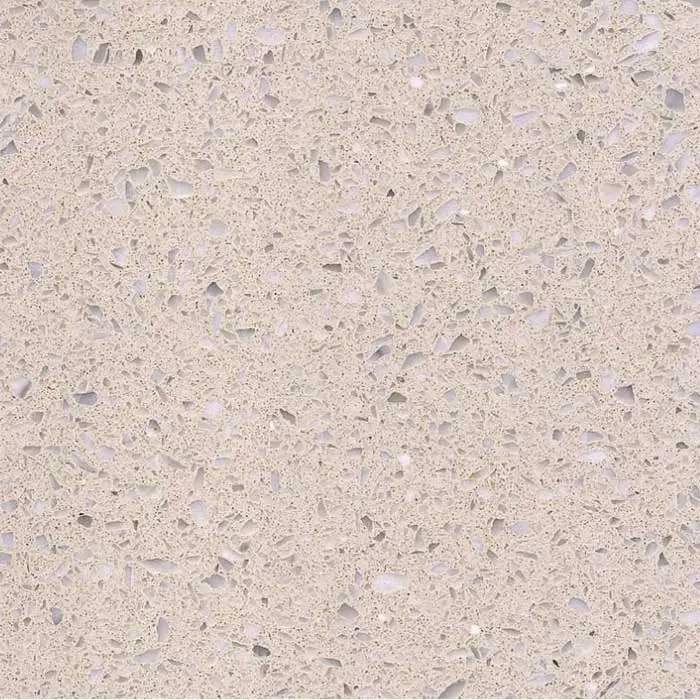Many people have questions about the composition of terrazzo stone and its relationship with quartz: Is terrazzo stone a type of quartz? How to identify them?
This article will discuss the difference between terrazzo stone and quartz in detail from a scientific perspective, and introduce some practical identification methods.

Basic Concepts of Terrazzo Stone and Quartz
1. Basic concepts of terrazzo stone
Terrazzo stone, also known as grinding stone, is a man-made composite floor material. It is made by mixing cement, sand, gravel, pigment and other materials, and then undergoing a series of processes such as pouring, compacting, grinding and polishing. Terrazzo stone tile has a smooth surface, high hardness, wear resistance and beauty, and is widely used in commercial places, public facilities and home decoration.
2. Basic concepts of quartz
Quartz is a common natural mineral whose main component is silicon dioxide (SiO2). Quartz has a unique crystal structure, extremely high hardness and chemical stability, and is widely present in the earth's crust. Due to its pure white or colorless appearance, quartz is widely used in glass manufacturing, ceramics, refractory materials and electronics industries.
What is the difference between terrazzo stone and quartz?
To understand whether terrazzo stone flooring is a type of quartz, we first need to clarify their composition and properties.
1. Difference in composition and properties
(1) Composition of terrazzo stone
Terrazzo stone tile is a composite material made of a mixture of various materials. Its main components include cement, sand, gravel and pigment. Among them, cement is used as a binder to bond aggregates such as sand and gravel together. After grinding and polishing, a smooth and dense surface is formed. The specific composition of terrazzo stone tile can be adjusted according to needs to achieve different physical properties and decorative effects.
(2) Composition of quartz
The main component of quartz is silicon dioxide (SiO2), and its crystal structure is trigonal. Quartz has extremely high hardness (Mohs hardness is 7) and excellent chemical stability, and is not easily corroded by chemicals such as acids and alkalis. Natural quartz often presents a transparent or translucent appearance and has good optical properties.
2. Differences in the formation process
(1) Terrazzo stone formation process
The formation of terrazzo stone flooring is a man-made process. First, cement, sand, gravel and pigment are mixed in a certain proportion; then the mixture is poured into a mold and compacted; after the cement hardens, it is polished and polished several times to form a smooth surface. The whole process requires strict control of material proportions and construction processes to ensure the quality and aesthetics of terrazzo stone.
(2) Quartz formation process
Quartz is a natural mineral that undergoes complex geological processes. Quartz is formed mainly through the following ways: first, quartz crystals precipitated during the cooling and crystallization of magma; second, quartz veins formed by the deposition of hydrothermal fluids containing silica in the cracks of the earth's crust; third, quartz particles in sandstone and shale formed under sedimentation. During the formation of quartz, other minerals are often deposited, so natural quartz crystals often contain impurities and inclusions.

How to distinguish terrazzo stone from quartz?
1. Appearance and texture
(1) Appearance and texture of terrazzo stone
The appearance of terrazzo stone tile usually presents uniform color and pattern, and its surface is smooth and flat. After grinding and polishing, it has a high gloss. Since terrazzo stone tile is a man-made material, its color and pattern can be designed and adjusted according to needs, so it has a strong decorative effect.
(2) Appearance and texture of quartz
Natural quartz crystals usually present a transparent or translucent appearance and have a glassy luster. Quartz has a hard texture and makes a crisp sound when knocked. Due to the complex formation process of natural quartz, its surface often contains impurities and inclusions, and the color and transparency may vary.
2. Hardness and wear resistance
(1) Hardness and wear resistance of terrazzo stone
The hardness and wear resistance of terrazzo stone flooring mainly depend on its composition and production process. Generally, the hardness of terrazzo stone slab is about 5-6 on the Mohs hardness scale, and the compressive strength can reach 40-60 MPa, with good wear resistance and impact resistance.
(2) Hardness and wear resistance of quartz
The hardness of quartz is 7 on the Mohs hardness scale, with extremely high wear resistance and compressive strength. Since quartz has good chemical stability and is not easily corroded by chemicals such as acids and alkalis, it performs well in terms of wear resistance and chemical resistance.

3. Physical and chemical tests
(1) Physical tests
Physical tests can distinguish terrazzo stone from quartz by simple methods. For example, a hardness test method can be used to scratch the surface of the sample with a substance with a higher hardness (such as a steel knife or glass). If a clear scratch can be made, it means that the sample has a lower hardness and may be a terrazzo stone slab; if no scratch can be made, it means that the sample has a higher hardness and may be quartz.
(2) Chemical tests
Chemical tests can distinguish terrazzo stone from quartz by using chemical reagents such as acids and alkalis. For example, dilute hydrochloric acid can be dripped on the surface of the sample. If there is an obvious reaction on the surface of the sample (such as bubbling or smoking), it means that the sample may be terrazzo stone; if there is no obvious reaction, it means that the sample may be quartz. Since quartz has good chemical stability and is not easy to react with acids and alkalis, this method can be used for preliminary identification.
4. Professional testing instruments
If conditions permit, professional testing instruments can be used for identification. For example, an X-ray diffractometer (XRD) can be used to detect the crystal structure of the sample to determine whether it is quartz; a scanning electron microscope (SEM) can be used to observe the microstructure of the sample and further identify terrazzo stone slabs and quartz. In addition, instruments such as Fourier transform infrared spectrometers (FTIR) can be used for composition analysis to help accurately identify the composition of the sample.
In summary, there are significant differences between terrazzo stone and quartz in terms of composition, properties, formation process, and application scenarios. Terrazzo stone flooring is a man-made composite material made of cement, sand, gravel and pigment, while quartz is a natural mineral whose main component is silicon dioxide (SiO2). Terrazzo stone slab and quartz can be effectively identified by appearance, texture, hardness, chemical reaction and professional testing instruments.

